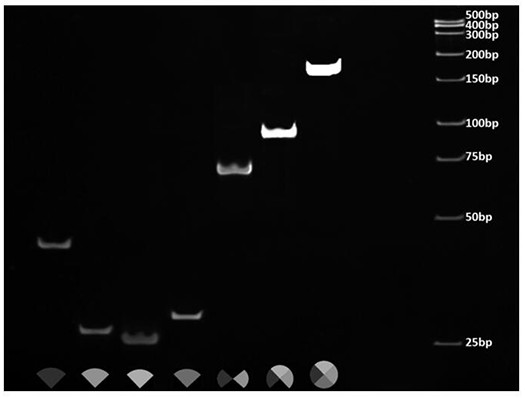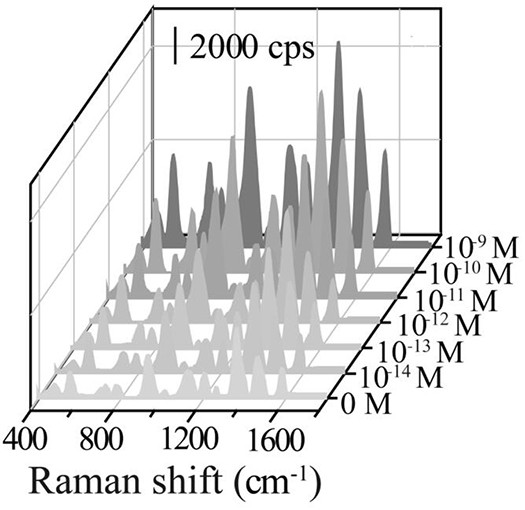A tetrahedral frame nucleic acid sERS probe, sensor and preparation method and application thereof
A tetrahedron and sensor technology, applied in biochemical equipment and methods, instruments, scientific instruments, etc., can solve the problems of poor enhancement effect of metal nanoparticles, expensive detection instruments, unstable detection signals, etc., to improve the spatial positioning range and accessibility, improve biorecognition efficiency, and reduce the effect of non-specific adsorption
- Summary
- Abstract
- Description
- Claims
- Application Information
AI Technical Summary
Problems solved by technology
Method used
Image
Examples
Embodiment 1
[0048] Preparation of tFNA probes
[0049] Take 1 μL each of 100 μM Tetra-A, Tetra-B, Tetra-C and Tetra-D, 10 μL of 30 mM tris(2-carboxyethyl)phosphine (TCEP) and 86 μL of TM buffer solution (made up of 20 mM Tris-HCl, 50 mM MgCl 2 •6H 2 O composition, pH 8.0) and mix well. After heating at 95 °C for 10 minutes, the temperature was rapidly lowered to 4 °C for more than 30 seconds, and the temperature was controlled with a PCR instrument to obtain a tFNA probe containing functionalized nucleic acid with a final concentration of 1 μM. Characterized by gel electrophoresis images, figure 1 From left to right are Tetra-A single-strand solution, Tetra-B single-strand solution, Tetra-C single-strand solution, Tetra-D single-strand solution, Tetra-A and Tetra-B two strands hybridized solution, Tetra -A, Tetra-B and Tetra-C three-chain hybridization solution, Tetra-A, Tetra-B, Tetra-C and Tetra-D four-chain hybridization solution (ie tFNA), DNA Marker solution. Because the molecu...
Embodiment 2
[0051] Preparation of long-range substrates
[0052] A gold film with a thickness of 100 nm was deposited on a glass substrate with a length and width of 1 cm × 1 cm by a thermal evaporator at 2 × 10 -6 The thickness of the Au film was controlled at a deposition rate of 0.02 nm / s at a pressure of mbar. Then MgF with a thickness of 200 nm was 2 Thermal evaporation coating onto gold surface to form MgF 2 / Au mirror / glass multilayer structure (for its synthesis reference ACS Appl. Mater. Interfaces 2021, 13(15), 18301–18313). Take 6 mL of prepared gold nano-hexagonal plate particles with an optical density of 2 (the synthetic reference is Adv. Optical Mater. 2016, 4, 76–85), add it to a 10 mL beaker, and add 2 mL of n-hexane to form water / n-hexane interface, drop 1-2 mL of ethanol into the above solution at a rate of 0.1 mL / min. Discontinuous golden luster hexagonal plate islands appear at the water / n-hexane interface at this time, and then these hexagonal plate islands rap...
Embodiment 3
[0054] Assembly of tFNA probes on long-range SERS substrates
[0055] 100 μL of 1 μM tFNA probe prepared in Example 1 was dropped on the LR-SERS substrate prepared in Example 2, and incubated at 37°C for 2 hours, so that the three vertices of the tFNA probe were self-assembled and connected by Au-S bonds. On the long-range SERS substrate, rinse with TM buffer to remove the unbound tFNA probe, and record the Raman response signal, because the Raman signal of Cy5 on the tFNA probe molecule is recorded. At this time, Cy5 is closer to the substrate surface, The peak intensity is about 10795 cps and the Raman signal is strong.
PUM
| Property | Measurement | Unit |
|---|---|---|
| length | aaaaa | aaaaa |
| height | aaaaa | aaaaa |
| recovery rate | aaaaa | aaaaa |
Abstract
Description
Claims
Application Information
 Login to View More
Login to View More - R&D
- Intellectual Property
- Life Sciences
- Materials
- Tech Scout
- Unparalleled Data Quality
- Higher Quality Content
- 60% Fewer Hallucinations
Browse by: Latest US Patents, China's latest patents, Technical Efficacy Thesaurus, Application Domain, Technology Topic, Popular Technical Reports.
© 2025 PatSnap. All rights reserved.Legal|Privacy policy|Modern Slavery Act Transparency Statement|Sitemap|About US| Contact US: help@patsnap.com



